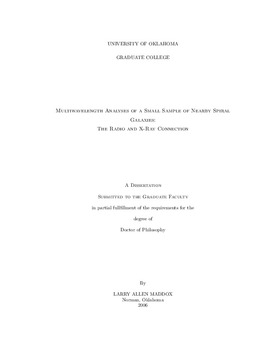| dc.contributor.advisor | Cowan, John J., | en_US |
| dc.contributor.author | Maddox, Larry Allen. | en_US |
| dc.date.accessioned | 2013-08-16T12:20:21Z | |
| dc.date.available | 2013-08-16T12:20:21Z | |
| dc.date.issued | 2006 | en_US |
| dc.identifier.uri | https://hdl.handle.net/11244/1076 | |
| dc.description.abstract | Included is a preliminary report on radio analyses of M101 and NGC 3184. The deep radio observations of M101 yield 28 compact radio sources. A shorter set of observations for NGC 3184 yield the detection of 10 radio sources. Six were seen at both 6 cm and 20cm, all with non-thermal continuum spectra. | en_US |
| dc.description.abstract | We report the results of a day long observation of the ringed, barred spiral galaxy NGC 6300 by XMM-Newton. We present an analysis of non-nuclear emission and report the discovery of two non-nuclear point sources. We present analysis of these point sources in multiple wavelengths using data from Anglo-Australian Observatory, Australia Telescope and HST. (Abstract shortened by UMI.) | en_US |
| dc.description.abstract | We report the analyses of deep radio observations of the interacting galaxy system M51 from the Very Large Array. We detect emission from the Type Ic SN 1994I nearly a decade after explosion. We find that the emission (160 +/- 22 muJy beam-1 at 20 cm, 46 +/- 11 muJy beam -1 at 6cm, alpha = -1.02 +/- 0.28) is consistent with light curve models for Type Ib/Ic supernovae. We detect X-ray emission from the supernova, but no optical counterpart is detected. We compare our radio maps with a deep Halpha image from a Hubble Space Telescope observations using the Advanced Camera for Surveys. We find that six of the associated Halpha sources are young SNRs with resolved shells. | en_US |
| dc.description.abstract | We present analyses of deep radio observations of M83 taken with the Very Large Array spanning fifteen years, including never before published observations from 1990 and 1998. We report on the evolution of 55 individual point sources, which include four of the six known historical supernovae in this galaxy. A total of 10 sources have X-ray counterparts from a Chandra survey. Each of these sources show non-thermal spectral indices, and most appear to be X-ray supernova remnants. Comparing the radio source list to surveys in optical and X-ray, we identify three optical/X-ray supernova remnants. Nearly half of the detected radio sources in these observations are coincident with known HII regions lying in the spiral arm structures of the galaxy. We also report on changes in emission from the complex nuclear region, which has shown variability at 20cm wavelengths. We confirm that the peak radio emission from the nucleus is not coincident with the known optical center. One lesser nuclear peak is consistent with the optical/IR nucleus. Previous dynamical studies of a "dark" nuclear mass indicate a possible match to other radio nuclear emission regions in M83. | en_US |
| dc.format.extent | xiv, 187 leaves : | en_US |
| dc.subject | X-ray astronomy. | en_US |
| dc.subject | Spiral galaxies. | en_US |
| dc.subject | Radio astronomy. | en_US |
| dc.subject | X-ray binaries. | en_US |
| dc.subject | Physics, Astronomy and Astrophysics. | en_US |
| dc.title | Multiwavelength analyses of a small sample of nearby spiral galaxies: The radio and X-ray connection. | en_US |
| dc.type | Thesis | en_US |
| dc.thesis.degree | Ph.D. | en_US |
| dc.thesis.degreeDiscipline | Homer L. Dodge Department of Physics and Astronomy | en_US |
| dc.note | Source: Dissertation Abstracts International, Volume: 67-06, Section: B, page: 3178. | en_US |
| dc.note | Adviser: John J. Cowan. | en_US |
| ou.identifier | (UMI)AAI3222155 | en_US |
| ou.group | College of Arts and Sciences::Homer L. Dodge Department of Physics and Astronomy | |
